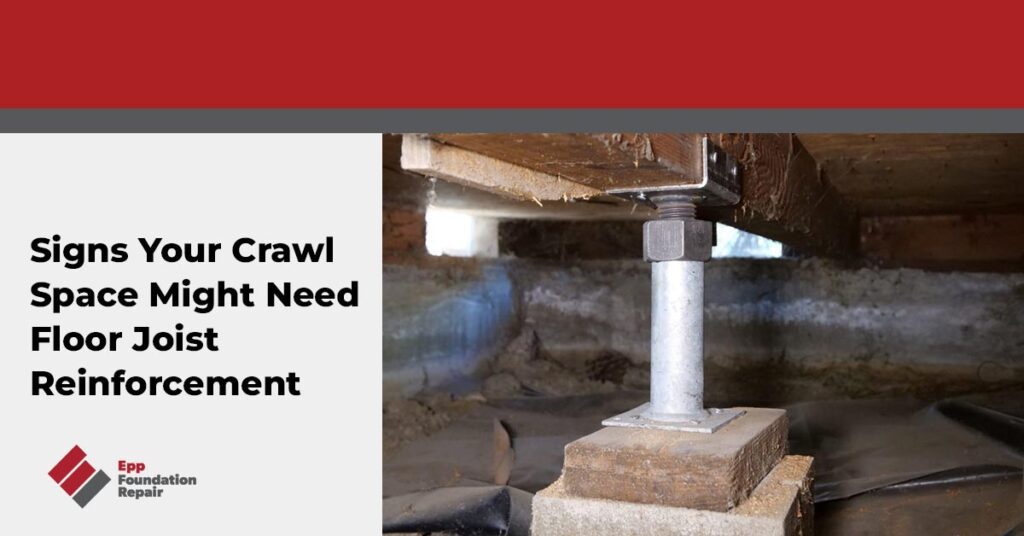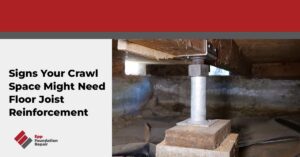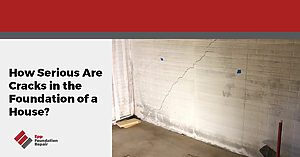Searching for information about floor joist reinforcement? If so, don’t hit that back button because you’ve landed on the right page. In this article, we’re going to review crawl space foundations, floor joists, common structural problems with crawl space foundations, repair solutions and more.
What Is A Crawl Space Foundation?
A crawl space foundation is a type of foundation commonly used in residential construction. It creates a space between the ground and the bottom of the first floor that’s typically around 2-3 feet high, just enough room to crawl around. The crawl space is usually accessed from outside the house or from inside via a closet.
Crawl space foundations have been popular for decades because they provide easy access to the home’s plumbing and electrical components.
The benefits of crawl space foundations include the following:
- Maintenance and repairs are easier because the plumbing and electrical systems are accessed via the crawl space.
- They’re more affordable than basement foundations because they require less excavation and materials to construct.
- Because they’re elevated off the ground, they can be built on uneven terrain, saving on costly site preparation.
- They can provide additional storage space for your home. By encapsulating the crawl space, you can create a clean, dry area that can be used to store items you don’t regularly use, such as tools and holiday decorations.
Crawl space foundations also have some disadvantages, including the following:
- They provide a habitat for pests and rodents. This can include insects, spiders, mice, rats, and even snakes. Once they gain access to your home through the crawl space, they can cause damage to your property and become a health hazard.
- Crawl spaces are also notorious for being damp and humid environments. This can lead to mold growth, rotting wood, and musty odors. Moisture can also cause damage to insulation and ductwork, leading to reduced energy efficiency and higher heating and cooling costs.
- Crawl spaces can cause energy loss if unconditioned, making the living area above the crawl space cold during the winter.
What Are Floor Joists?
Floor joists (see the infographic below) are a structural element in the crawl space that support the ground floor. They are placed on top of the beams (also known as girders). The size and strength of the floor joists are determined by the type of flooring system installed above it.
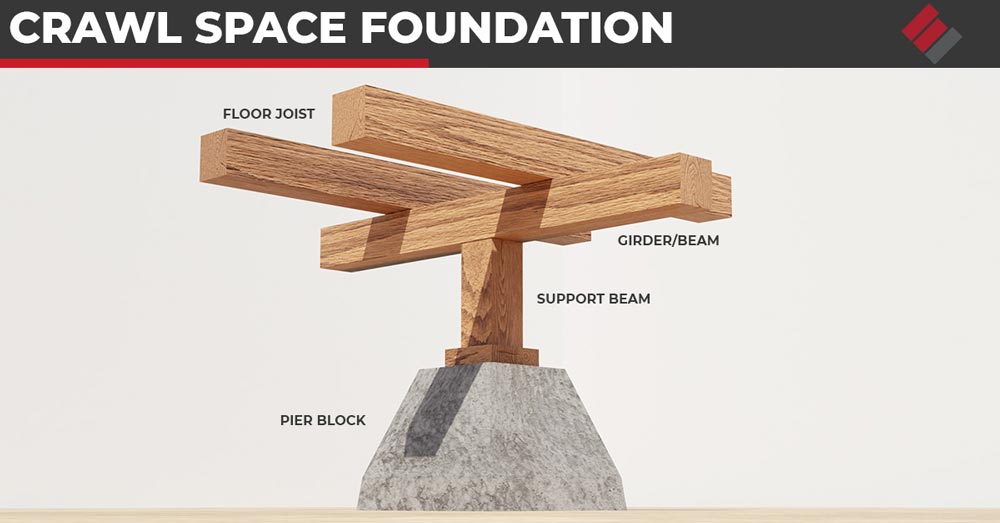
Common Causes Of Structural Problems With Crawl Space Foundations
If the structural elements in the crawl space are exposed to moisture, pests, and other environmental factors, it can lead to problems. Here are some of the most common issues with floor joists in crawl spaces:
- Moisture damage – Moisture is a major enemy of wooden joists. Moisture in crawl spaces can come from various sources, including a high groundwater table, condensation, and plumbing leaks. When floor joists are constantly exposed to moisture, they can start to rot, warp, and weaken. This can cause the floors above the joists to sag or become uneven.
- Pests – Crawl spaces are also attractive to pests like termites, ants, and rodents. These creatures can cause serious damage to wooden joists by chewing on them or building nests inside them. Over time, damage caused by pests can weaken the joists and compromise the integrity of the entire structure.
- Improper installation – In some cases, the joists in the crawl space may have been installed incorrectly. For example, they may not be spaced properly or may not be level. This can cause the floors above to become uneven or creaky.
- Wear and tear – Even if the joists have been installed correctly and protected from moisture and pests, they can still wear out over time. This is especially true in older homes where the joists may have been in place for decades. Over time, the wood can become brittle and weak, making it more susceptible to damage from environmental factors.
Signs Your Crawl Space Might Need Floor Joist Reinforcement
Signs you might need floor joist reinforcement include the following:
- Sagging or uneven floors – If you notice your floors are uneven or sagging, it’s time to take a closer look at your crawl space. Sagging floors are a telltale sign that your floor joists can no longer support the ground floor’s weight.
- Bouncy floors – If your floors feel bouncy when you walk on them, it could be a sign your floor joists have weakened and need reinforcement.
- Wall cracks -Another sign your crawl space needs attention is the presence of wall cracks. As your floor joists weaken, they may cause your walls to shift, leading to visible cracks.
- Musty odors – If you notice a musty or damp smell coming from your crawl space, it could be a sign of mold growth caused by excessive humidity. This can weaken your floor joists over time.
- Pests – Pests such as termites or carpenter ants can wreak havoc on your crawl space. They can eat away at your wooden floor joists, weakening them and putting your home at risk.
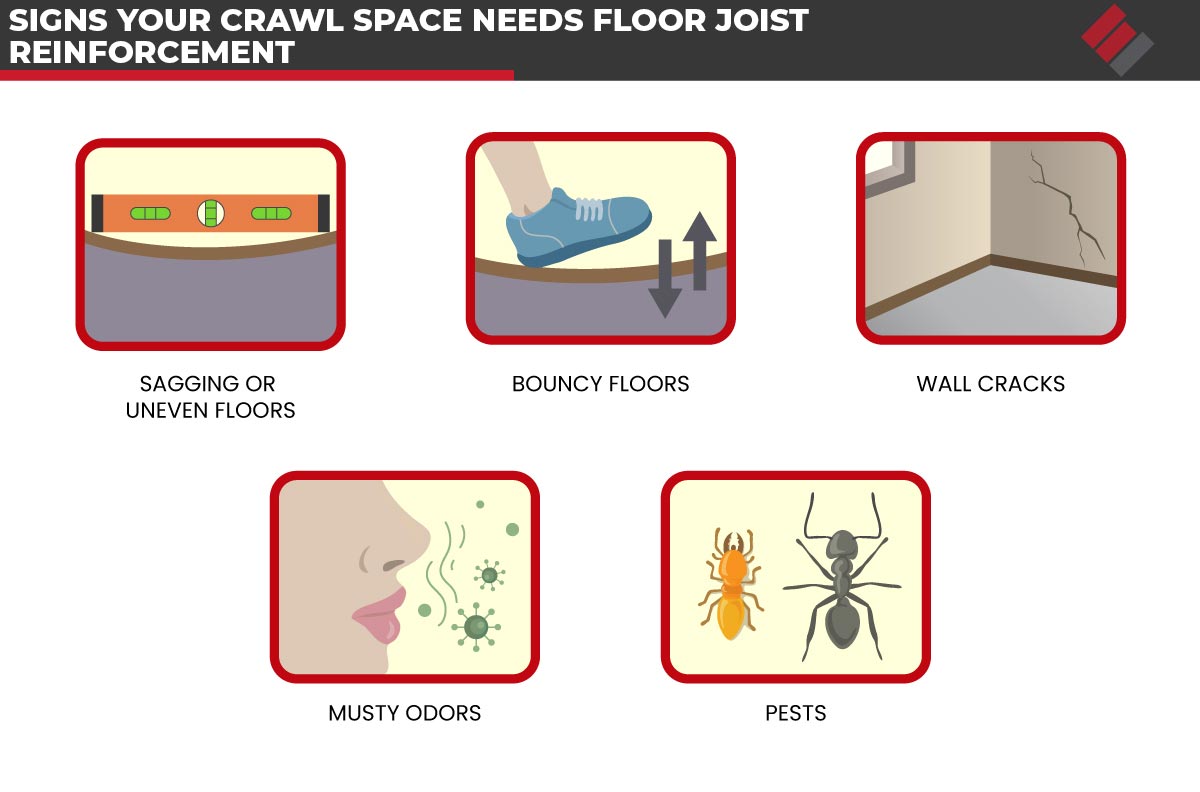
It’s essential to watch for the above signs to ensure your crawl space is in good condition. Regular maintenance can help prevent costly repairs and ensure the safety of your home.
For more information, read more about – Sagging floor repair cost.
Repair Solutions For Structural Problems In A Crawl Space
Possible repair solutions for structural problems in a crawl space include the following:
- Floor joist reinforcement – Floor joist reinforcement involves the installation of additional supports and braces to shore up the existing joists. Adjustable screw jacks can be added to reinforce the floor joists. For more information, check out our blog about – Crawl space jack.
- Encapsulation – Encapsulating a crawl space involves covering the floor and walls with a thick, vapor-retarding barrier. This prevents moisture from entering the crawl space and causing trouble. A dehumidifier is often added to ensure the humidity level remains low. An encapsulated crawl space can be used as an extra storage space.
- Drain tile system – Often, structural problems in a crawl space are caused by poor drainage around the foundation. If this is the case, installing a drain tile system will ensure the ground around the foundation remains dry. For more information, see How Does A Drain Tile System Work?
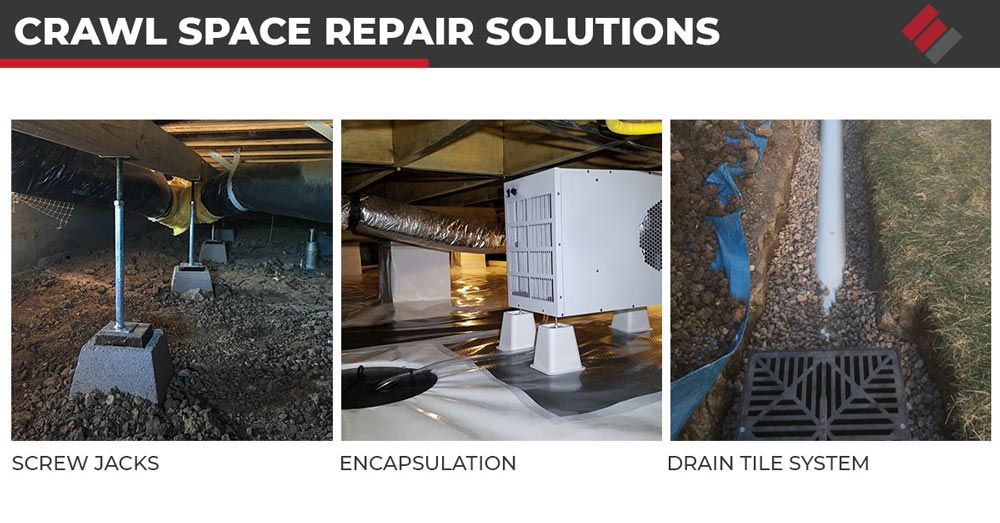
How To Prevent Structural Problems In A Crawl Space
The best way to prevent structural issues in a crawl space is to ensure the area is clean and dry. Here are some ways to do that:
- Ensure groundwater flows away from the foundation – Water pooling around your home’s foundation can lead to structural problems in the crawl space. Therefore, you should ensure the yard slopes away from the house so groundwater drains away from the foundation.
- Ensure there aren’t any plumbing leaks in the crawl space – This will help prevent mold growth.
- Encapsulate the crawl space – Encapsulating the crawl space along with a dehumidifier is a great way to keep the crawl space clean and dry.
- Install a drain tile system – A drain tile system will ensure the ground around the foundation remains dry.
If you think your home’s crawl space might need floor joist reinforcement, contact us today to schedule an evaluation. We serve areas in four states: Nebraska, Iowa, Kansas, and Missouri.

